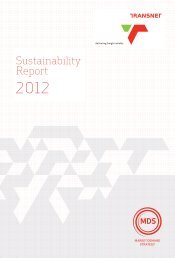Noise and Vibration Report - Transnet
Noise and Vibration Report - Transnet
Noise and Vibration Report - Transnet
- No tags were found...
You also want an ePaper? Increase the reach of your titles
YUMPU automatically turns print PDFs into web optimized ePapers that Google loves.
ENVIRO-ACOUSTIC RESEARCHSCOPING NOISE REPORT – TRANSNET: SWAZI RAIL LINK – DAVEL YARD TO NERSTON RSA ROUTEIt states that noise prevention <strong>and</strong> mitigation measures should be applied where predicted ormeasured noise impacts from a project facility or operations exceed the applicable noise levelguideline at the most sensitive point of reception. The preferred method for controlling noisefrom stationary sources is to implement noise control measures at source.It goes as far as to proposed methods for the prevention <strong>and</strong> control of noise emissions,including:• Selecting equipment with lower sound power levels;• Installing silencers for fans;• Installing suitable mufflers on engine exhausts <strong>and</strong> compressor components;• Installing acoustic enclosures for equipment casing radiating noise;• Improving the acoustic performance of constructed buildings, apply sound insulation;• Installing acoustic barriers without gaps <strong>and</strong> with a continuous minimum surfacedensity of 10 kg/m 2 in order to minimize the transmission of sound through thebarrier. Barriers should be located as close to the source or to the receptor location tobe effective;• Installing vibration isolation for mechanical equipment;• Limiting the hours of operation for specific pieces of equipment or operations,especially mobile sources operating through community areas ;• Re-locating noise sources to less sensitive areas to take advantage of distance <strong>and</strong>shielding;• Placement of permanent facilities away from community areas if possible;• Taking advantage of the natural topography as a noise buffer during facility design;• Reducing project traffic routing through community areas wherever possible;• Planning flight routes, timing <strong>and</strong> altitude for aircraft (airplane <strong>and</strong> helicopter) flyingover community areas; <strong>and</strong>• Developing a mechanism to record <strong>and</strong> respond to complaints.It sets noise level guidelines (see Table 2-1) as well as highlighting the certain monitoringrequirements pre- <strong>and</strong> post-development.Table 2-1: IFC Table .7.1-<strong>Noise</strong> Level GuidelinesOne hour L Aeq (dBA)Receptor typeDaytime07:00 - 22:00Night-time22:00 – 07:00Residential; institutional; educational 55 45Industrial; commercial 70 70P a g e | 14
















